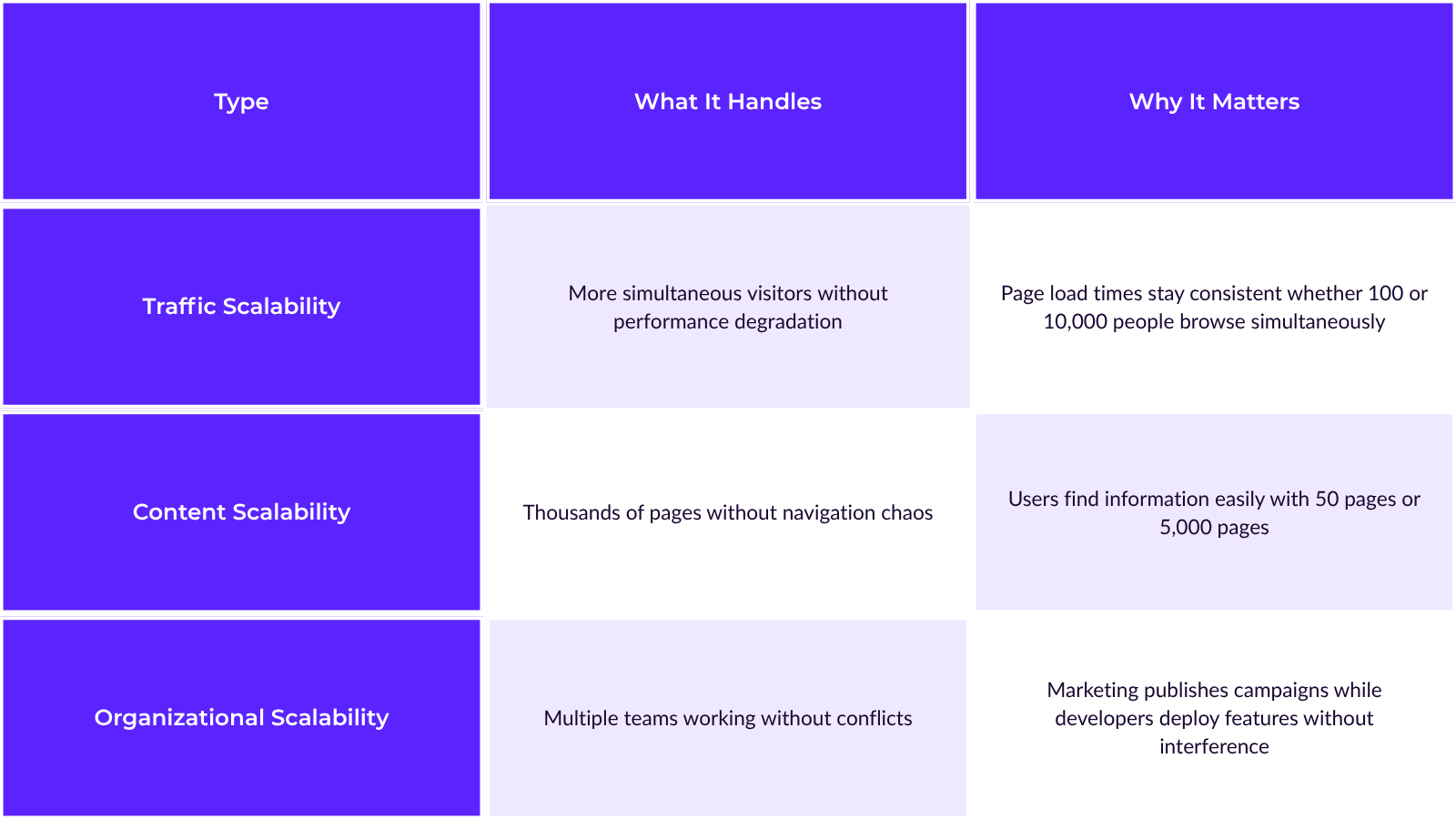How to Enhance User Experience Through Scalable Website Design
Your marketing team launches a brilliant campaign that goes viral. Traffic explodes overnight. But instead of celebrating, you're watching your site crash under the load. Frustrated users bounce away, potential customers disappear, and what should have been your biggest win becomes an expensive lesson.
Organizations invest heavily in driving traffic but neglect the foundation that makes great user experiences possible at scale. They treat scalability as a technical afterthought rather than a user experience imperative. Website performance and UX are inseparably linked, when one fails, the other suffers immediately. Scalable website design enhances user experience, and good user experience requires scalable design.
Why UX Design Is So Important for Website Scalability
Most marketing leaders understand that user experience matters. What they often miss is how directly scalability impacts that experience. A beautiful website becomes useless when it can't handle success.
Scalability affects every aspect of user interaction. Page load times, form submissions, search functionality, content discovery. Everything users care about depends on your site's ability to perform consistently under varying conditions.
Think about the last time you used a slow website. Did you question the organization's competence? Did you wonder if they could deliver on their promises? That's exactly what happens when scalability problems create user experience failures.
What Makes a Website Scalable?
Scalability sounds like a technical concept, but it's really about the consistency in user experience. Ask yourself this question: can your site deliver the same quality experience to your 10,000th visitor as it does to your first?
True scalability means your website works just as well with 100 users as it does with 10,000 users. Performance stays consistent whether you're handling normal traffic or unexpected spikes. You can add new content, features, and team members without breaking existing functionality.
But scalability encompasses more than just handling traffic. Your content management workflows need to scale too. Publishing one blog post per month requires different processes than publishing five posts per day. Managing ten product pages needs different organization than managing 8000 product pages.
Successful scaling requires thoughtful information architecture from the beginning. You can't retrofit good organization onto a flimsy foundation.
What Are the Three Types of Scalability?
Understanding the different dimensions of scalability helps you plan for growth across all aspects of your website:

These types of scalability work together. Traffic spikes often coincide with content publishing deadlines and feature launches. Black Friday traffic surges happen while marketing teams publish last-minute promotional content and developers deploy checkout improvements. Your site needs to handle all three simultaneously.
How Poor Scalability Harms User Experience
Users don't distinguish between technical problems and experience problems. They don't care if your database is overwhelmed or your CDN is misconfigured. They just know your site doesn't work when they need it.
When Success Becomes Your Website's Worst Enemy
The warning signs are small at first. Maybe your contact form occasionally fails to submit. Perhaps your search feature returns results slowly during peak hours. These minor hiccups feel manageable until they're not.
Real problems emerge when success amplifies every weakness. Your marketing campaign goes viral, but your website crashes when people try to sign up. Forms stop working under heavy traffic, turning qualified leads into frustrated visitors who'll never return.
53% of mobile users abandon sites taking over 3 seconds to load. When scaling problems cause page load times to stretch to 10+ seconds, you're damaging your brand's reputation.
Database queries that worked fine with 100 concurrent users become bottlenecks with 1000 users. Content delivery networks that seemed adequate suddenly can't keep up with demand. Every system reveals its limitations precisely when you need it most.
Users get error messages when trying to complete important tasks. That contact form they filled out carefully returns a 500 error. The checkout process they trusted with their payment information suddenly breaks. The search function that helped them find exactly what they needed stops returning relevant results.
The Real Cost to Your Business and Users
84% of organizations feel their CMS prevents unlocking content value. When content creators can't efficiently publish relevant, timely information, users suffer from outdated and poorly organized content. Search functionality becomes useless as your content library grows without proper taxonomy. Navigation menus become overwhelming mazes with too many options.
New features break existing workflows that users depend on. The blog subscription process that worked perfectly for months suddenly conflicts with your new newsletter system. 92% of organizations struggle with content consistency across systems. Users notice inconsistencies immediately.
The real cost is staggering. Slow-loading websites lead to $2.6 billion in annual lost sales. When your site doesn't meet user expectations, user trust erodes. If your site crashes during their first visit, they assume it will crash again.
The irony is these failures can happen during your biggest opportunities. Black Friday sales, product launches, viral social media moments. The times when perfect user experience matters most are exactly when poor scalability does the most damage. You lose competitive advantage when users choose competitors with better experiences.
How Do You Build Scalable Websites?
Building scalable user experiences requires thinking about growth from day one. Understanding website scalability principles helps organizations plan for sustainable growth. You can't retrofit scalability onto poorly designed sites any more than you can add good user experience to poorly architected systems. Scaling websites successfully requires strategic planning, not reactive fixes.
Design Principles for Scalable UX
These UX design best practices form the foundation of scalable websites that can grow without sacrificing user experience.
Build with reusable components that work across different page types. Modular design systems make scaling efficient and consistent. Instead of designing each new page from scratch, you combine proven components in new ways.
Design with APIs so new features integrate cleanly with existing systems. Well-designed APIs allow functionality to expand without affecting core user workflows that users depend on.
Use modular architecture where new components don't interfere with existing ones. Each feature should stand alone while integrating seamlessly with the whole. Users shouldn't notice when you add new capabilities behind the scenes.
Separate content management from presentation so you can update either independently. This flexibility becomes crucial as organizations grow. Marketing teams can focus on content while designers improve visual elements without conflicts.
Plan for mobile-first experiences that work regardless of screen size. Mobile usage continues growing, and mobile performance matters more for user experience than desktop performance. Sites that work beautifully on phones typically work well everywhere else.
Performance and Technical Scalability
Building scalable web architecture requires optimization strategies that maintain performance under increasing load. B2B sites loading in 1 second have 3x higher conversion rates than sites loading in 5 seconds. This performance gap compounds as traffic increases, especially as Core Web Vitals requirements evolved in 2024 with additional metrics that better reflect real user experiences.
Key optimization strategies include:
- Optimize images properly using modern formats, compression without quality loss, and lazy loading implementation
- Set up effective caching so repeat visitors don't wait for content to reload
- Use content delivery networks to serve files from locations closer to users
- Monitor database performance and optimize slow queries before they impact users
Monitor Core Web Vitals using modern performance monitoring techniques. These metrics reflect real user experiences, not theoretical performance. Use real user monitoring to understand actual user experiences.
Track user behavior patterns to identify where people struggle with your interface. Heat maps, session recordings, and user flow analysis reveal friction points that traditional analytics miss. Set up alerts for performance thresholds so you can fix problems quickly.
Content and Team Scalability
Design navigation that works with 50 pages and accommodates 5000 pages. Your information architecture should support growth instead of breaking down as you add content. Apply effective information architecture strategies to support growth.
Implement search functionality that helps users find specific content quickly. Search becomes more important as sites grow larger, but it only helps if it returns relevant, accurate results. Build content workflows that don't break when multiple people publish simultaneously.
Create design systems with reusable components that everyone follows. Consistent visual language makes sites feel professional and trustworthy. Establish clear guidelines for when and how to modify existing designs. Set up review processes to catch inconsistencies before they reach users.
Follow ethical design principles to ensure consistency and user empowerment. Use tools that help teams collaborate without overwriting each other's work.
Test new features thoroughly before they go live. Proper testing prevents new functionality from breaking existing workflows. Plan feature rollouts gradually so users can adapt to changes.
Why Drupal Enterprise Solutions Excel at Scalable UX
Drupal powers thousands of high-traffic, enterprise websites including major universities, government agencies, and Fortune 500 companies. Its architecture is specifically designed for organizations with complex content workflows and demanding scalability requirements.
Built-in multi-site management helps organizations with multiple properties maintain consistent user experiences. Robust caching systems maintain performance under heavy load without requiring custom development. Workflow tools support complex content approval processes that larger organizations require. API-first architecture integrates with existing business systems seamlessly.
Early Warning Signs Your Website Isn't Scaling
Watch for these key indicators that your website is struggling to handle growth:
- Content updates take much longer than they used to - what once required five minutes now takes thirty minutes
- Users report that search results are becoming less useful - search functionality becomes unreliable as content libraries grow
- New features consistently break existing functionality - feature additions create problems with workflows users depend on
- Performance degrades noticeably during busy periods - sites become sluggish during peak traffic when users are most engaged
Implement proactive website maintenance to prevent problems before they affect user experience.
Ready to Build a Website That Scales With Your Success?
Future-proof website design anticipates growth challenges and builds solutions that adapt to changing needs. The organizations that succeed treat scalability as a user experience advantage, not a technical constraint.
ImageX specializes in enterprise Drupal solutions that grow with your organization. Our approach focuses on long-term scalability rather than quick fixes that create bigger problems later.
We help you avoid the costly mistakes that create scaling problems down the road. Poor architectural decisions become expensive to fix after launch. Smart planning prevents these problems and creates competitive advantages.
Our professional UX design services ensure your website scales with your business needs while maintaining the user experience quality that drives results. The investment in scalable design pays dividends every time your marketing succeeds beyond expectations.
Contributors









